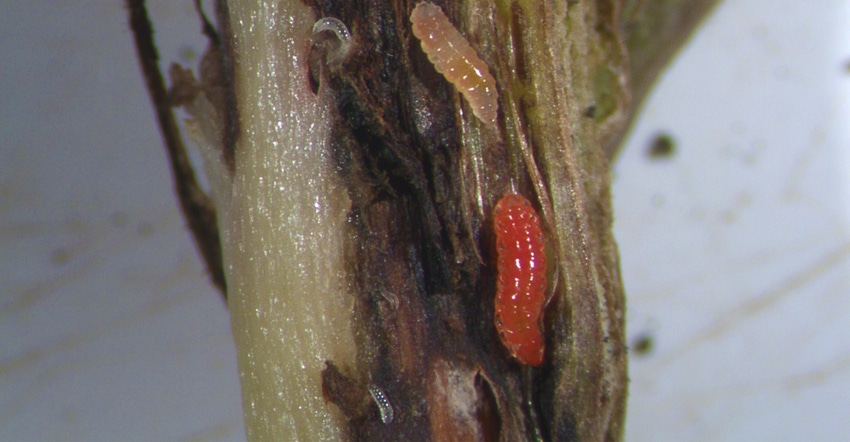January 21, 2021

One of our most recent and enigmatic soybean pests, soybean gall midge, seems to keep expanding its range. Found in northeast Nebraska in 2011, it was thought to be a secondary issue associated with damage from hail or disease. In subsequent seasons, isolated gall midge infestations were noted in South Dakota, Minnesota and Iowa. But it was still seemingly tied to damaged or diseased plants, without impacting yield directly.
Unfortunately, in 2018 gall midge changed the game. It was found in 65 counties in the north-central region, including 16 in Iowa, with significant yield loss reported in many of the midge-infested fields. Since then, soybean gall midge injury has been reported in five states and 114 counties.
At the end of the 2020 growing season, Iowa had 31 counties with gall midge infestations. But while it seems like the trend is for increasing problems with gall midge, we really don’t know for sure. Researchers point out that this pest is so new, nobody can be certain if the soybean gall midge will persist in areas where it caused economic losses in previous years or if it will spread to other areas.
What are they?
Midges belong to a large and diverse family of flies, which includes Hessian fly and wheat midge, wheat pests that you may be familiar with. Soybean gall midge overwinters as larvae in the first few inches of soil. After pupation in the early spring, adult midges emerge and lay their eggs at the base or lower stems of soybean plants.
The eggs hatch and the larvae feed on the stems. Infestation tends to occur around the V3 stage and can continue into the reproductive growth stages. There can be at least two generations per growing season. The adult gall midge does not feed on soybeans.
Damage and scouting
The fly is small and pretty tough to find and identify during traditional field scouting, but since I am often asked what they look like, they are about a quarter-inch long with white- and black-banded legs and an orange abdomen. As we go forward working on management strategies, using insect traps to understand when the flies emerge may be one of the ways we scout for them.
For now, we focus on scouting for plant symptoms and gall midge larvae. Start scouting soybeans after the V2 growth stage. Wilting or dead soybeans along field edges with decreasing damage into the center of the field is usually the first sign of infestation. Look for dark discoloration at the base of the stem. Heavily infested plants eventually wilt and die. Stems of infested plants become brittle and can break near their base.
Peel back the epidermis of the stem and look for small, orange larvae, which is considered diagnostic for this pest. The heaviest infestations have been observed in fields next to a field that had been planted to soybeans in the previous year.
What can we do about them?
It’s not the answer we want, but the bottom line is that this is a very new pest; there just aren’t any published research-based management recommendations — yet. But researchers are gaining ground. Soybean checkoff funding is supporting on-farm studies in multiple states on the efficacy of cultural practices and insecticides. One of the leading researchers is our own Iowa State University entomologist Erin Hodgson, who has been working on soybean gall midge from the start.
A collaborative project in Iowa, Minnesota and Nebraska that she helped lead illustrates how challenging this pest is to manage and why we can’t just go spray insecticides around V2 or V3 to manage gall midge. She and fellow researchers collected over 4,500 adults across 900 locations in the 2020 growing season to help understand the emergence and life-cycle patterns of soybean gall midge. The duration of gall midge emergence was 25.6 days in the 2020 growing season, nine days longer than in the 2019 growing season. Hodgson points out that long emergence windows like that make finding a chemical solution challenging.
The good news is that several projects she and fellow researchers are involved in are showing some promise in gall midge management. Because the strategies cover a pretty broad range, including both chemical and cultural, I can’t do them justice here, so the best way to get the latest info is straight from Hodgson and her fellow researchers.
She and other Extension entomologists from three regional universities hosted a free Soybean Gall Midge Discussion Series recently to share the latest updates. Register here and you can watch the three roughly hour-long discussions at extension.umn.edu.
To watch for and assist with management strategies of soybean gall midge, the Soybean Gall Midge Alert Network has been established. It’s a network of 36 sites across four states. Go to soybeangallmidge.org to learn more.
McGrath is an Iowa State University Extension field agronomist and the On-farm Research and Extension coordinator for ISU’s Iowa Soybean Research Center.
About the Author(s)
You May Also Like






